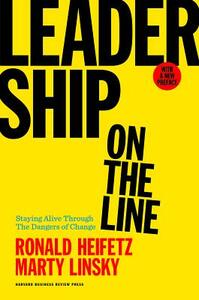Take a photo of a barcode or cover
22 reviews for:
Leadership on the Line: Staying Alive Through the Dangers of Change
Marty Linsky, Ronald A. Heifetz
22 reviews for:
Leadership on the Line: Staying Alive Through the Dangers of Change
Marty Linsky, Ronald A. Heifetz
4.5 stars. I came to this book somewhat sceptical that a book on leadership by two old white dudes, originally published in 2002, would be worth reading today. I was wrong. While the examples are fairly dates, this book is crammed with hard-earned wisdom on staying alive while in leadership. To my surprise, it’s also deeply spiritual (in the right ways). I hope to come back to my notes on this one often in the years (and decades) ahead.
This is a great book. It gives solid examples of how to be a leader and what it takes. It's meditative and reflective. Opened my eyes to focus more and listen more. Would recommend to anyone wanting to move up in the world and to not fear what others might think about you.
Probably would have been 4 stars if I wasn’t required to read it for a class.
I was thinking that this may have been the best book I've read about leadership, but then I starting thinking, "have I ever read any other books about leadership?" I suppose Traction: Get A Grip On Your Business may arguably count, but it's necessarily different. Anyway, I didn't hate it, and felt like I gleaned something from it. 3.5 stars, rounded down, because I was required to read this for work.
Only after finishing this book did I realize there is a new addition published in 2017. This was recommended to me a long time ago. Written in 2002, I figured too much has changed for this book to hold its early 2000s value.
I was wrong. A book about adaptive change holds heavy relevance in 2021 when leaders the wold over are trying to navigate challenges and changes driven by a global pandemic.
What I found most refreshing about the book is the practical focus. It isn’t an idealistic book like some leadership books are. It’s more thorns than roses which feels like real-life leadership and not just fancy Linked-In title leadership.
There are a few moments where it is very clear this book was written in the early 2000s, and there are gaps or neglected topics more relevant today, particularly for women and BIPOC in leadership. That aside, the principles are useful to a leadership practitioner.
Key points / takeaways:
The problems in adaptive leadership.
- People don’t resist change, per say, they resist loss.
- The sustainability of change depends on having people with the problems internalize the change itself.
- For the most part, people criticize you when they take issue with the message or change. But rather than focus on the issue and debating it’s merits, they find it more effective to discredit you.
- The persistence of conflict usually indicates that people have not yet made adjustments and accepted the losses that accompany adaptive change.
As a leader - here are practical tips.
- As leaders, after listening to people’s stories about the issue, you have to listen to the song beneath their words.
- To do this, you have to “get on the balcony.” Get above the ballroom floor to get perspective on individual dances.
- People who oppose what you’re trying to accomplish are usually those with the most to lose from your success. In contrast, your allies have the least to lose. For that reason, your opposition deserves more of your attention as a matter of both compassion and strategy.
- People need to know that you know what you are asking them to give up on the path to creating a better future. Grieve with them and memorialize the loss. Then focus on the vision.
- For adaptive challenges, you need partners. You also need to be willing to take some casualties and let people go.
- One of the greatest challenges of adaptive leadership is - keeping stress at a productive level!
Some personal vs role notes - to protect you the leader.
- Don’t confuse your role with your person. Even when others’ responses to you seem very personal, you need to read them primarily as reactions to how well you are meeting THEIR expectations. Decipher criticism before internalizing it.
- Losing yourself in your role is a sign that you depend on the institution or community for meeting too many of your personal needs, which is dangerous.
- It’s the easy way out to criticize the person rather than the message itself. For example, some might accuse a courageous woman of being pushy if she seeks to change the culture of the organization. By making her style or character the issue, those who are threatened distract people in the organization from her message. Discrediting her reduces the credibility of her perspective.
- The key is to respond to the attack in a way that places focus back where it should be - on the message or issues.
- You must differentiate yourself from your role - this doesn’t mean you need to distance yourself or withhold yourself. You can embody a work challenge while still differentiating your person from your role.
- Understand the difference between a confidant and an ally. Allies are with you on the issue - which means they may also be with you as a person, but not always. Once they are against you on the issue - they aren’t an Allie. In short - allies aren’t singularly for you. A confidant is someone outside of all the issue to you. They are singularly with you as a person always. Many people confuse the two roles.
I was wrong. A book about adaptive change holds heavy relevance in 2021 when leaders the wold over are trying to navigate challenges and changes driven by a global pandemic.
What I found most refreshing about the book is the practical focus. It isn’t an idealistic book like some leadership books are. It’s more thorns than roses which feels like real-life leadership and not just fancy Linked-In title leadership.
There are a few moments where it is very clear this book was written in the early 2000s, and there are gaps or neglected topics more relevant today, particularly for women and BIPOC in leadership. That aside, the principles are useful to a leadership practitioner.
Key points / takeaways:
The problems in adaptive leadership.
- People don’t resist change, per say, they resist loss.
- The sustainability of change depends on having people with the problems internalize the change itself.
- For the most part, people criticize you when they take issue with the message or change. But rather than focus on the issue and debating it’s merits, they find it more effective to discredit you.
- The persistence of conflict usually indicates that people have not yet made adjustments and accepted the losses that accompany adaptive change.
As a leader - here are practical tips.
- As leaders, after listening to people’s stories about the issue, you have to listen to the song beneath their words.
- To do this, you have to “get on the balcony.” Get above the ballroom floor to get perspective on individual dances.
- People who oppose what you’re trying to accomplish are usually those with the most to lose from your success. In contrast, your allies have the least to lose. For that reason, your opposition deserves more of your attention as a matter of both compassion and strategy.
- People need to know that you know what you are asking them to give up on the path to creating a better future. Grieve with them and memorialize the loss. Then focus on the vision.
- For adaptive challenges, you need partners. You also need to be willing to take some casualties and let people go.
- One of the greatest challenges of adaptive leadership is - keeping stress at a productive level!
Some personal vs role notes - to protect you the leader.
- Don’t confuse your role with your person. Even when others’ responses to you seem very personal, you need to read them primarily as reactions to how well you are meeting THEIR expectations. Decipher criticism before internalizing it.
- Losing yourself in your role is a sign that you depend on the institution or community for meeting too many of your personal needs, which is dangerous.
- It’s the easy way out to criticize the person rather than the message itself. For example, some might accuse a courageous woman of being pushy if she seeks to change the culture of the organization. By making her style or character the issue, those who are threatened distract people in the organization from her message. Discrediting her reduces the credibility of her perspective.
- The key is to respond to the attack in a way that places focus back where it should be - on the message or issues.
- You must differentiate yourself from your role - this doesn’t mean you need to distance yourself or withhold yourself. You can embody a work challenge while still differentiating your person from your role.
- Understand the difference between a confidant and an ally. Allies are with you on the issue - which means they may also be with you as a person, but not always. Once they are against you on the issue - they aren’t an Allie. In short - allies aren’t singularly for you. A confidant is someone outside of all the issue to you. They are singularly with you as a person always. Many people confuse the two roles.
A bit clinical at times, both Heifetz and Linky clearly define and exemplify the successes and pitfalls of leadership in action. It leans pretty heavy on government or big-business type examples, but there are still learnings for anyone leading in any capacity from this book. I've pulled from several of the lessons, and continue to work on improving my ability to lead through adaptive changes.
informative
inspiring
reflective
medium-paced
Skewed more towards politics than I was expecting, really didn't connect with author who came off pretentiousness and less well supported with research than what I look for. Some content used as examples of points have become tarnished or irrelevant in more recent years eg. Apologist sections about Bill Clinton or pointing to the EU as an indicator or growing unity and cooperation.






